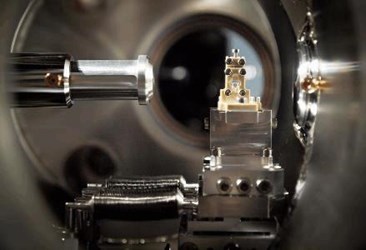Plasma Accelerator Produces First X-Ray Light

Milestone for next generation research light sources
For the first time, a plasma accelerator has generated X-ray light at DESY. The LUX plant, headed by Dr. Andreas Maier from the University of Hamburg delivered ultrasound radiation pulses with a wavelength of nine nanometers (millionths of a millimeter). This corresponds to so-called soft x-ray radiation. "This is an important milestone for the development of novel accelerated X-ray sources," emphasizes Prof. Florian Grüner, Head of Accelerator Physics at the University of Hamburg. LUX (Latin "light") is part of the LAOLA cooperation between DESY and the university. "I am very pleased that another important success has been achieved in the accelerated research activities, which were set up several years ago," says the director of the DESY Accelerator Division, Dr. Reinhard Brinkmann.
The technology of plasma acceleration promises physicists a new generation of powerful particle accelerators with unique properties for different applications. In this method, a laser or an energetic particle beam produces a plasma wave in a fine capillary. The plasma is an electrically charged gas. At the present time, the technique is in the experimental stage, and some development work is still necessary until practical use.
"LUX uses a 200 trillion-watt laser that shoots ultra-lightning into a hydrogen gas," says Maier. "In the wake of each flash, electrons accumulate which are then accelerated by the electrically positively charged plasma wave in front of them - similar to a wakeboard surfer in the stern wave of a ship."
In this way, electrons in the plasma cavity of the LUX accelerator, which is only a few millimeters long, reach an energy of up to 600 million electronvolt (600 MeV), which is more than the LINAC II linear pre-accelerator at DESY.
For the first time, the Maier team, who developed and built the plant, has now led the fast electrons from their plasma cells to produce X-ray light. To do so, they sent the short electron packets to a 50 cm-long magnetic slalom range in which an extremely strong magnetic field changes its direction every 2.5 millimeters. The electron energy dissipates in the form of X-ray radiation due to the course in the so-called undulator.
According to the same principle, large X-ray light sources at DESY, such as the storage ring PETRA III or the European X-ray laser European XFEL, also produce their radiation. LUX has now delivered the first X-ray light from a plasma accelerator on the DESY campus. "This has been achieved by a handful of research groups all over the world," emphasizes Maier. "The great support of the participating technical groups is a major contributor to the success."
Although LUX does not achieve the same brightness as the large systems, research with X-ray light can open up new applications in the future. "On the one hand, we produce extremely short X-ray flashes," says Maier. "The plasma wave at LUX is only 0.01 millimeters short and thus the electron packets can no longer be longer. This leads to X-ray flashes, which last only three to five femtoseconds. "A femtosecond is a billionth of a second, a millionth of a billionth of a second. "This would allow the flashes to capture extremely fast events in the world of atoms and molecules."
Moreover, the operating principle of the installation means that the X-ray flash and the optical laser flash, which generates the plasma wave, are extremely precisely synchronized. In many experiments, researchers use an optical laser flash to trigger a reaction, the course of which is then examined with the most accurate delayed x-ray flashes. In LUX, a synchronization between X-ray and laser lightning on a single femtosecond is to be precisely achieved, as Maier reports.
Next, the physicists want to further optimize their plasma accelerators and their undulators to produce energy-efficient electrons as well as brighter and shorter-wave X-ray light. Finally, the researchers hope to improve their system so far that they achieve a self-amplifying laser process. This would lead to a compact X-ray laser. "This is our clear goal, but the road to it is still demanding", emphasizes Maier. "Such a project can only be achieved by the close cooperation between the two partner universities, DESY."
Within the framework of the LAOLA cooperation between the University of Hamburg and DESY, various groups from both institutions work closely together to explore future-oriented accelerator concepts. The cooperation was founded in 2011 by Grüner and Brinkmann. Another important cooperation partner is the ELI-Beamlines project in Prague (Czech Republic). The concept of plasma acceleration is researched at DESY in various projects with different objectives.
Source: DESY
